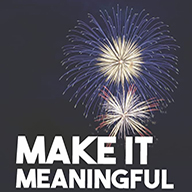- Home
- Articles
- Reviews
- About
- Archives
- Past Issues
- The eLearn Blog
Archives
| To leave a comment you must sign in. Please log in or create an ACM Account. Forgot your username or password? |
|
Create an ACM Account |

It is a rare read that manages to present both familiar and novel concepts while modeling the very practices it presents. Make It Meaningful: Taking Learning Design from Instructional to Transformational” by Dr. Clark Quinn does just that. You could read it in a single sitting or take it bit by bit as you work through the helpful Action and Reflection prompts found at the end of each chapter.
Quinn takes his own advice in the design of this work. The Principles and Practices sections are well designed to guide the reader through this quick read. Quinn shares an apt fishing metaphor that elicits the reader to engage with the content and to make meaningful connections to their current understanding of learning science and learner experience.
For some readers, there are many familiar concepts to consider, and the dichotomies of principles and practice, action and reflection, divergence and convergence, education and engagement, and frustration and failure are contextualized within psychology, evolutionary biology, and real-world experience.
In “Section 1: Principles,” the reader is provided with relevant information regarding learning and engagement. Quinn lays out the terms the reader needs and answers at the outset just what meaningful means in the context of the book. For Quinn “meaningful” means it’s interesting to us. He goes on to elaborate on the qualities that gain and sustain our interest as learners. The book then guides us through the fishing analogy, where the designers and educators are in the role of the fisherman, and the learners are the fish. First, we need to “hook ’em!” with the appropriate lure, then “land 'em!” by reeling them in through intentional engagement techniques. The section wraps up by providing a tacklebox of tips and tricks from humor and storytelling to challenge and social interaction.
In “Section 2: Practice,” the reader thinks through the implications of the principles presented in Section 1. The point is to be intentional about the choices you make—and the techniques you choose to employ—while keeping your focus on the learner by anticipating their needs, heading off their misconceptions, and calibrating the proper balance from a broad and colorful pallet of approaches. Quinn provides concept maps and graphic organizers for the dynamics and iterative flow of the design model he forwards. When the reader is well-acquainted with the design process, a call to action is presented on how the reader can move forward.
Unlike many presentations of traditional learning design models, Quinn goes beyond the mere naming of parts and defining terms. Make it Meaningful draws the reader’s attention to emotion, intrinsic motivation, and the touchstone triad of usability, effectiveness, and engagement. As the reader progresses, the realization that the book is effectively modeling the practices it is describing becomes unmistakable.
The book's structure means that you can engage with the content on many levels. Read it fast to remind you of what you thought you knew about learning and design. Pick and pull your favorite parts to apply to your practice or take your time and think through how to apply the model, tools, and techniques and use them as a roadmap for your next design challenge. In any case, Make It Meaningful will help you do just that for yourselves and those for whom you design.
Damien Michaud serves as Senior Learning Designer for Faculty Development at the University of Southern Maine. He holds a Ph.D. in urban education from the University of Wisconsin-Milwaukee, with a specialization in adult, continuing, and higher education leadership, and a focus on instructional design and learning technology. His research interests include the scholarship of teaching and learning, learning design, and virtual teams. He has published journal articles on enhancing student engagement in asynchronous online courses, leadership, and collaborative skill development for the digital world, and learning and working in interdependent virtual teams.
Permission to make digital or hard copies of all or part of this work for personal or classroom use is granted without fee provided that copies are not made or distributed for profit or commercial advantage and that copies bear this notice and the full citation on the first page. Copyrights for components of this work owned by others than ACM must be honored. Abstracting with credit is permitted. To copy otherwise, or republish, to post on servers or to redistribute to lists, requires prior specific permission and/or a fee. Request permissions from [email protected]
Copyright © ACM 2022. 1535-394X/2022/10-3568028 $15.00 https://doi.org/10.1145/3568028|
To leave a comment you must sign in. |
|
Create an ACM Account. |